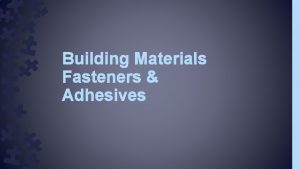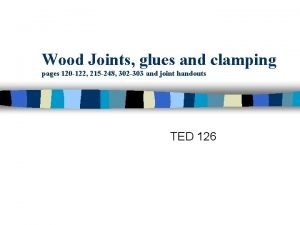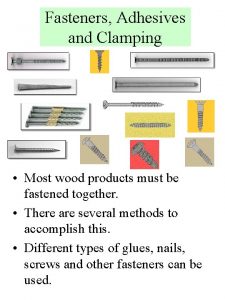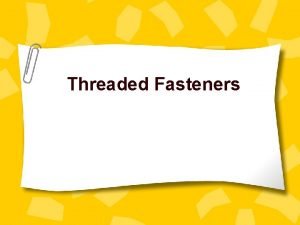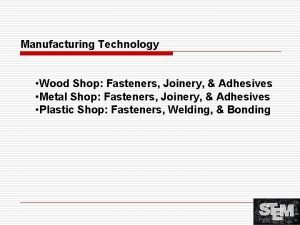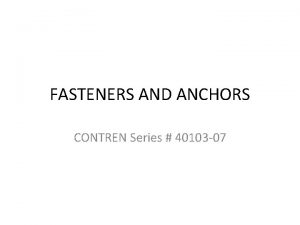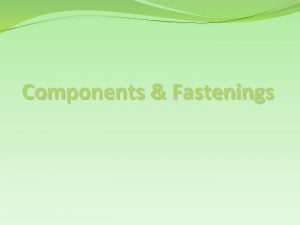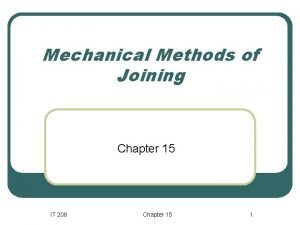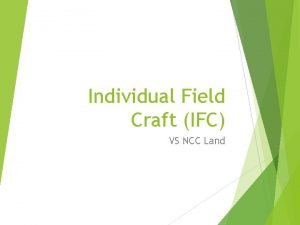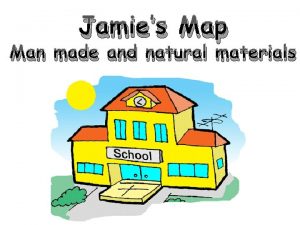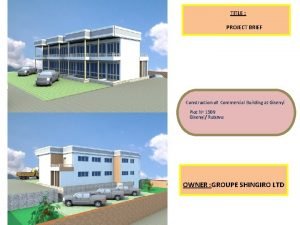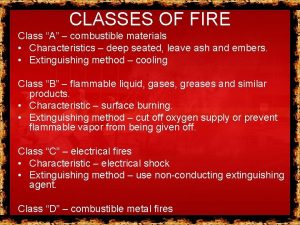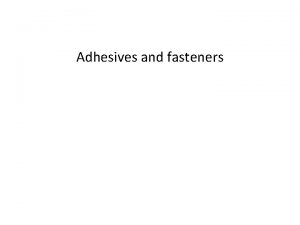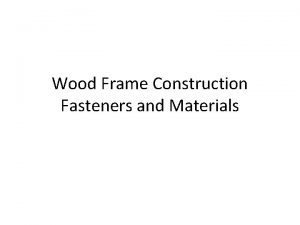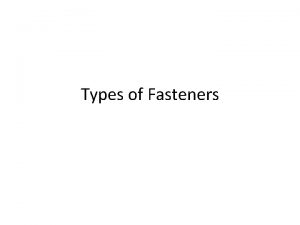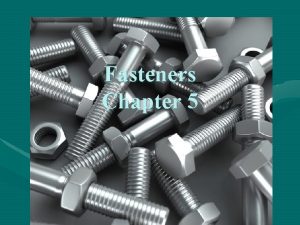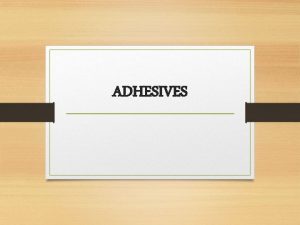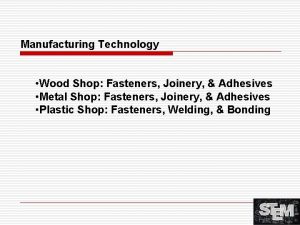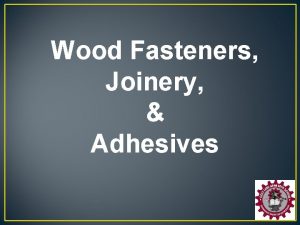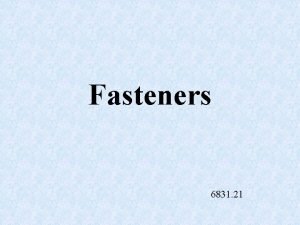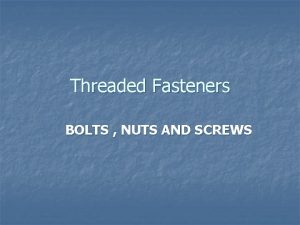Building Materials Fasteners Adhesives Objectives Identify various types

Building Materials Fasteners & Adhesives

Objectives › › › › Identify various types of building materials and their uses State various types of hardwoods and softwoods Identify the different grades and markings of wood building materials Identify the safety precautions associated with building materials Describe the proper methods for storing and handling building materials State the uses of various types of engineered lumber Calculate the quantities of lumber and wood products using industrystandard methods › Describe fasteners, anchors, and adhesives used in construction work.

Lumber Sources and Uses › It is important to distinguish lumber from wood. – Lumber – boards, timbers, etc. produced from sawmills. – Wood – refers to the material itself, which comes from many different species of trees.

Lumber Cutting › Most trees are sawed so that the growth rings form an angle of less than 45 degrees with the surface of the boards produced. These are referred to as flat-grained (softwoods) or plain-sawed (hardwoods).

Lumber Cutting › Cutting with the growth rings at an angle greater than 45 degrees is known as edge-grained/vertical grained (softwoods) and quarter-sawed (hardwoods)

Lumber Defects › Defects affect a lumbers quality or grade. – Defects can occur: › › Naturally During the cutting process While drying Improper storage or handling

Lumber Grading › Inspection criteria is established by the U. S. Department of Commerce and published as product standards. › Lumber is graded by inspectors who examine the wood after it is planed. › Grading is based on the number, size and types of defects which determine the load-carrying capacity. *The more defects the weaker the wood*

Grade Stamps › Can vary based on grade associations in different parts of the United States.

Grading Terms › Light Framing – members 2”-4” thick and 2”-4” wide › Joists & Planks – members 2”-4” thick and 5”-18” wide › Beams & Stringers – members at least 5” thick and no greater than 2” wide › Posts & Timbers – approx. square members at least 5”x 5”

Other Grading Terms › Nominal size – term by which it sold (NOT actual size) › Dressed size – actual size. Usually ½”-3/4” less than nominal size Example: 2 x 4 stud usually measures 1 ½” x 3 ½” › Dimensional lumber – supplied in nominal 2”, 3”, 4” thickness with standard widths. Light framing studs, joists and planks are classified as dimensional lumber.

Plywood › Made up of layers (plies) of wood veneers. Each layer may be 1/16” to 5/8” thick. – Veneers are made by rotary cutting of trees. https: //www. youtube. com/watch? v=9 tky. QXq. DYYg

Plywood Grading › Plywood is rated and stamped on the face veneer. – – Only the letters A, B, C, D, and N are used. N-grade used in high-quality applications for a natural finish A-grade accepts paint readily B-grade offers a solid surface with splits no larger than 1/32” and may be repaired with smooth plugs – C-grade may have splits to a maximum of ½” and up to 1 ½” knot holes – D-grade is the lowest quality plywood veneer.

Building Boards › Ingenuity and technology has helped the plywood industry develop other materials in sheet form. 1. Hardboard – sometimes called tempered or pegboard. – Tempered can be used in exterior applications – Pegboard is suitable for interior use such as cabinets

Building Boards 2. Particle Board – small particles or flakes of wood mixed with binding agents and pressed into sheet form. 3. High-Density Overlay (HDO) – abrasion and moistureresistant and can be used for concrete forms, cabinets, countertops and similar high-wear applications. 4. Oriented Strand Board (OSB) – used for wall and roof sheathing.

Review Day 1 › › › › › What is the difference between lumber and wood? Define the term quarter-sawed used for sawing hardwoods. Name the 4 ways defects can occur that can affect a lumbers grade. Who establishes the inspection criteria for lumber grading? What does the grading stamp S-DRY indicate? What size lumber is used for light framing? What type of lumber is classified as dimensional lumber? List the 5 grades of plywood from best to worst. What type of hardboard can be used in exterior applications? What type of plywood can be used for concrete forms?

Building Materials Fasteners & Adhesives Day 2

Engineered Wood Products › Engineered lumber products fall into five general classifications: 1. Laminated veneer lumber (LVL) 2. Parallel strand lumber (PSL) 3. Laminated strand lumber (LSL) 4. Wood I-beams 5. Glue-laminated lumber (glulam)

Laminated Veneer Lumber (LVL) › Like plywood LVL is made from laminated wood veneer › Used for floor and roof beams and headers

Parallel Strand Lumber (PSL) › Made from long strands of wood › Used for beams posts and columns

Laminated Strand Lumber (LSL) › Made from small logs of almost any kind of wood. › Used for millwork such as doors and windows

Wood I-Beams › Consist of a web with flanges bonded to the top and bottom. This mimics steel I-beams and provides exceptional strength. › Used for floor joists, rafters and headers

Glue-Laminated Lumber (glulam) › Made from lengths of solid, kiln-dried lumber that have been glued together. › Used for ridge beams, basement beams, headers, stringers and support.

Pressure-Treated Lumber › Softwood lumber protected by chemical preservatives forced deep into the wood through a vacuum-pressure process. › Used on and below ground-applications such as: landscape timbers, sill plates, and foundations.

Pressure Treated Lumber › Advantages: – Prevents decay and fungus growth – Insect resistant › Concerns: – When cutting always wear dust mask – Wash any skin exposed while handling – Wash clothing that is exposed to sawdust separately from other clothing – Do not burn any scrap pieces as the ash poses a health hazard

Calculating Lumber Quantities › Large quantities of lumber are normally ordered by the board foot. – A board foot is equivalent to a piece of lumber that is 1” thick, 12” wide and 1’ long.

Calculating Lumber Quantities 1. How many board feet are there in (100) 2”x 4”x 8’ studs? Width X Length X Thickness (in inches) (in feet) 4 X 800 X 2 12 (in inches) 12 = 533. 3 bd ft

Calculating Lumber Quantities 2. How many board feet are there in (10) 2”x 6”x 16’ joists? 3. How many board feet are there in (40) 2”x 4”x 12’ studs?

Review Questions Day 2 › What does LVL stand for? › What is Laminated Strand Lumber used for? › What are wood I-beams used for? › List the hazards associated with using pressure treated lumber. › What is the formula for calculating board feet? › If you have 20 pieces of 8 foot long 2”x 6” lumber, how many board feet do you have?

Building Materials Fasteners & Adhesives Day 3

Concrete Block Construction › Concrete masonry units (CMUs), commonly referred to as concrete block* are commonly used in building foundations and basement walls. *once called cinder block because it contained cinder ash from burning coal

Concrete Block › Typically 8”x 16” with a hollow core

Commercial Construction Methods › Structural framework of large buildings such as: office buildings, hospitals, apartments, and hotels is usually made from concrete or structural steel.

Commercial Construction Floors › Once the framework is in place, the concrete floors are poured using deck forms

Commercial Exterior Walls › When walls are formed of concrete, openings for doors and windows are made by inserting wooden or metal bucks in the form.

Metal Framing Materials › Include metal studs, metal joists and metal roof trusses. › Advantages: – – Lightweight Uniformity Rot resistant Ease of construction

Nails › Nailing is the most common method for attaching two pieces of lumber. › Nail sizes are referred to as 8 -penny, 10 -penny etc. – In written form penny is designated by the lower case “d”. Thus 8 d, 10 d etc.

Kinds of Nails › Common Nails – most frequently used with a flat head and smooth shank › Box Nails – similar to common nails except have a thinner head and shank and are less likely to split wood. › Finish Nails – small barrel shaped head with a slight indentation in the top to receive a nail set tool so the nail can be driven slightly below the surface of the wood › Casing Nails – look like a finish nail but they have a conical-shaped head and the shank is larger.

Kinds of Nails › Duplex Nails – designed for building scaffolds, concrete forms and other temporary work. › T-nails – specific to pneumatic nail guns. › Masonry/cut Nails – used in concrete work › Roofing Nails – galvanized and resist rusting.
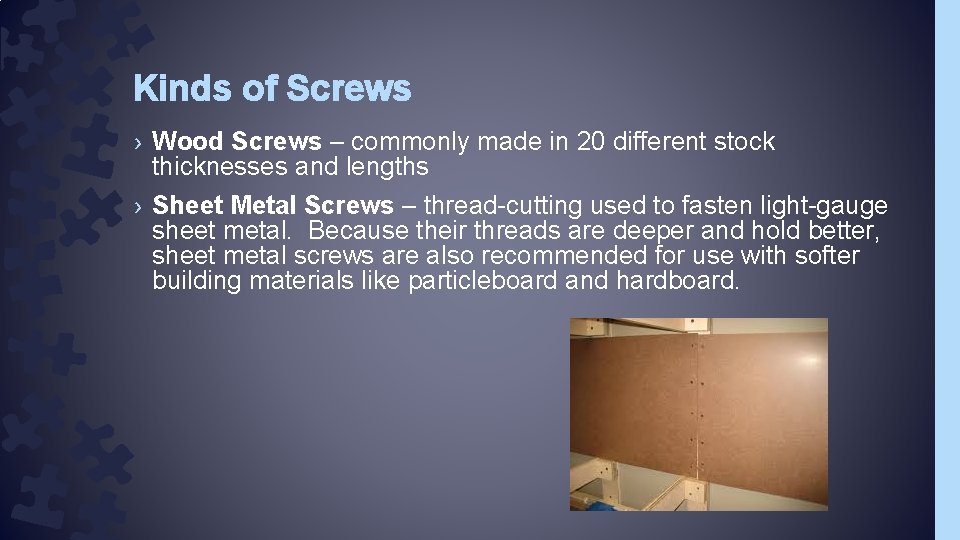
Kinds of Screws › Wood Screws – commonly made in 20 different stock thicknesses and lengths › Sheet Metal Screws – thread-cutting used to fasten light-gauge sheet metal. Because their threads are deeper and hold better, sheet metal screws are also recommended for use with softer building materials like particleboard and hardboard.

Kinds of Bolts › Stove Bolts – round or flat-head and threaded all the way to the head. › Machine Bolts – come with nuts normally the same thickness as the diameter of the bolt. Also come in decorative finishes. › Carriage Bolts – head is oval and she shank square so that the bolt can be driven or drawn into the wood and the nut tightened without the bolt turning.
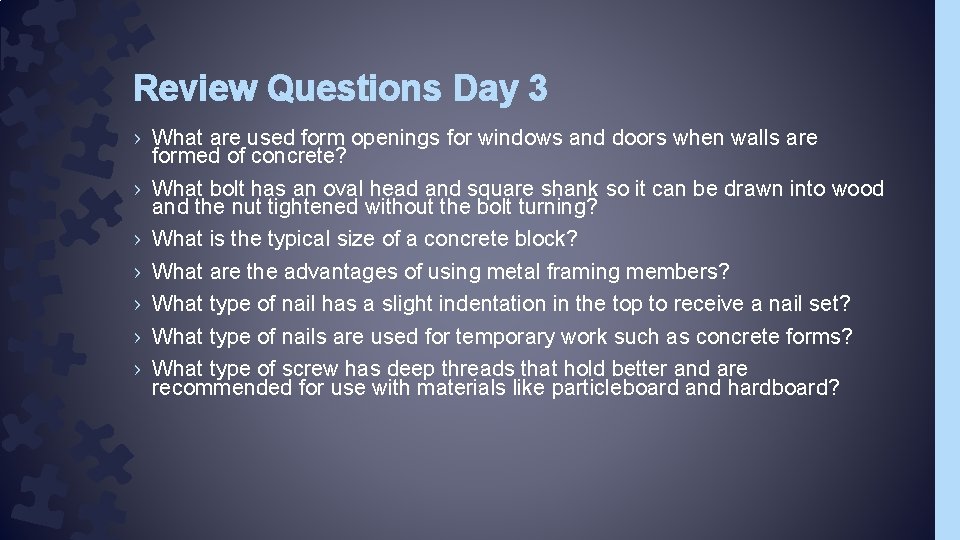
Review Questions Day 3 › What are used form openings for windows and doors when walls are formed of concrete? › What bolt has an oval head and square shank so it can be drawn into wood and the nut tightened without the bolt turning? › What is the typical size of a concrete block? › What are the advantages of using metal framing members? › What type of nail has a slight indentation in the top to receive a nail set? › What type of nails are used for temporary work such as concrete forms? › What type of screw has deep threads that hold better and are recommended for use with materials like particleboard and hardboard?

Building Materials Fasteners & Adhesives Day 4
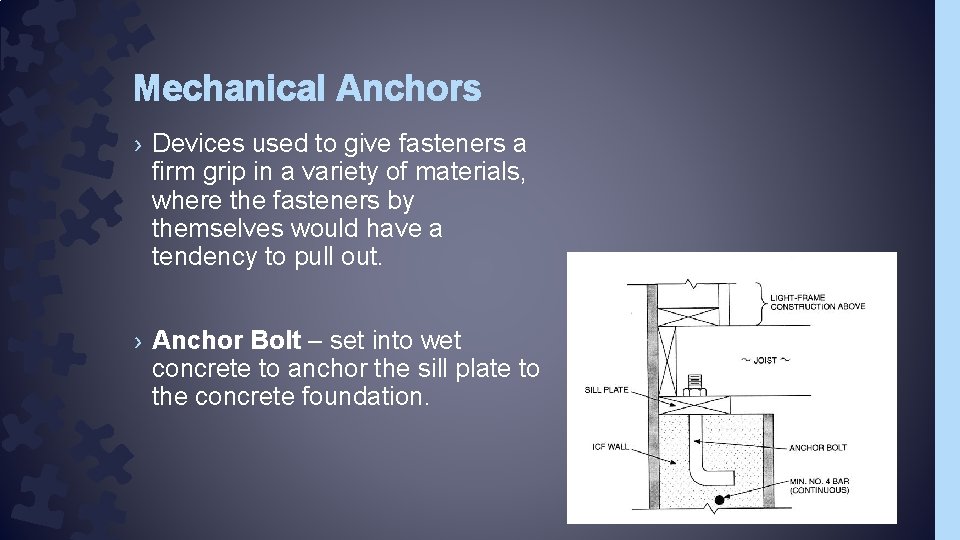
Mechanical Anchors › Devices used to give fasteners a firm grip in a variety of materials, where the fasteners by themselves would have a tendency to pull out. › Anchor Bolt – set into wet concrete to anchor the sill plate to the concrete foundation.
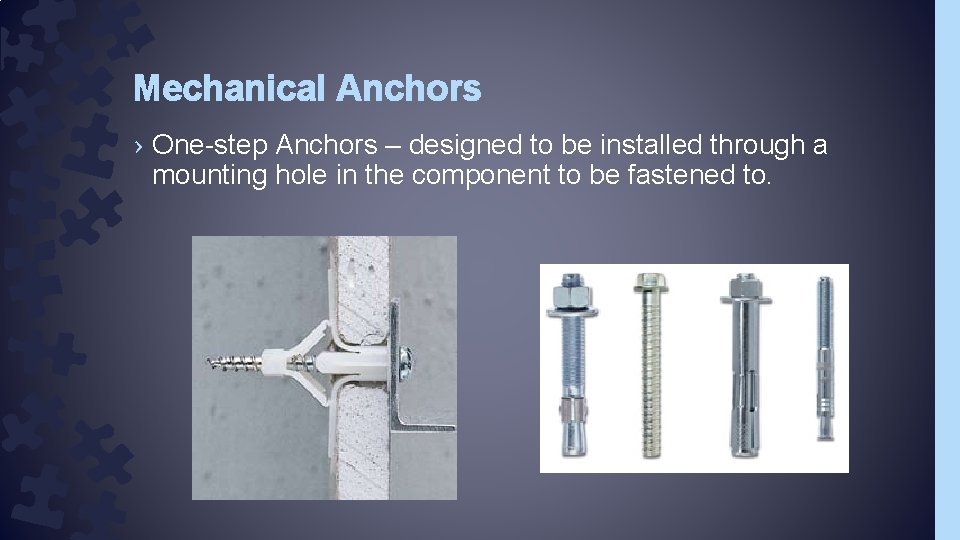
Mechanical Anchors › One-step Anchors – designed to be installed through a mounting hole in the component to be fastened to.
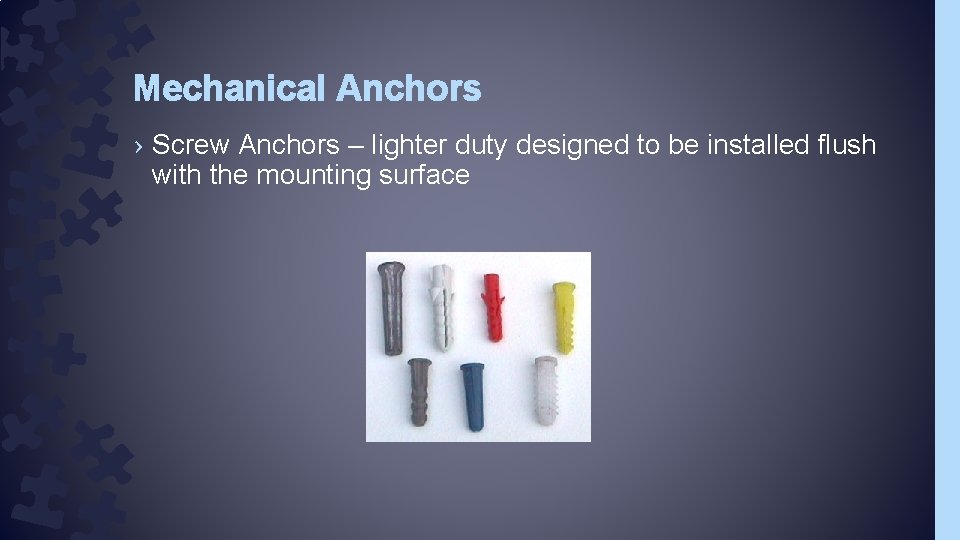
Mechanical Anchors › Screw Anchors – lighter duty designed to be installed flush with the mounting surface

Mechanical Anchors › Hollow-wall Anchors – used in hollow materials such as concrete plank, block, wall board and plaster. *Most commonly referred to as toggle bolts or wall anchors*

Adhesives › Are a variety of products that are used to attach one surface to another: – Glues - used in laminated construction such as arches, building beams, cabinets and millwork – Construction adhesives – usually applied from a cartridge with a manual ratchet-type gun. Epoxies use a dual cartridge applicator to mix the resin and hardener only at the time of use.
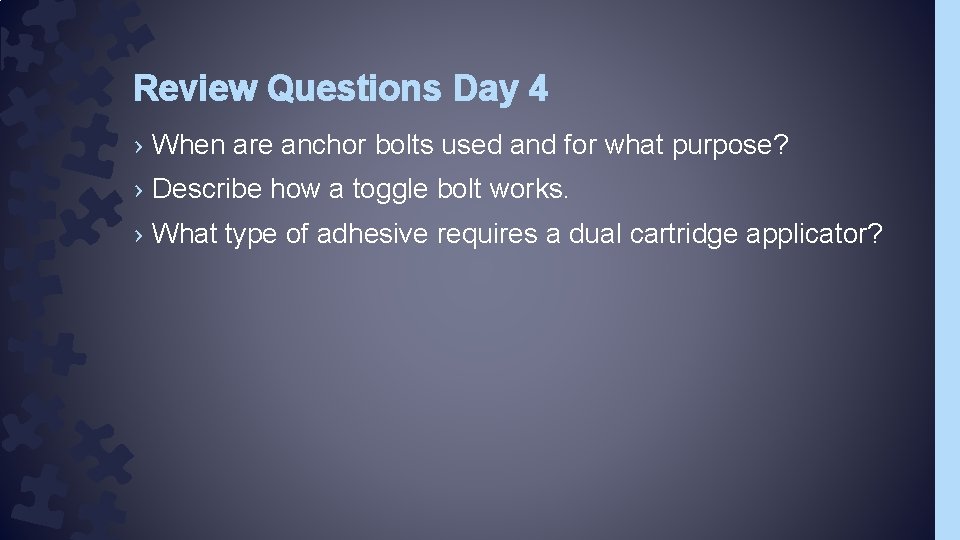
Review Questions Day 4 › When are anchor bolts used and for what purpose? › Describe how a toggle bolt works. › What type of adhesive requires a dual cartridge applicator?
- Slides: 48
